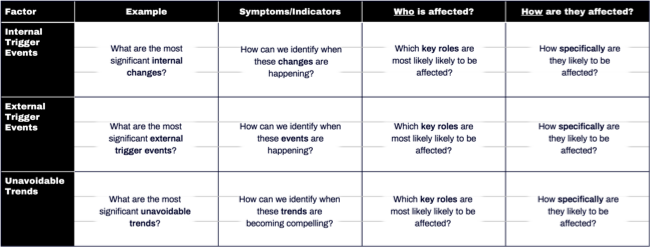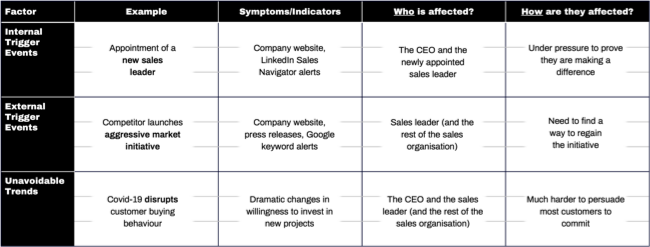In the previous article in this series on Outcome-Centric Selling® I addressed the importance of researching, targeting, and engaging the key roles in your ideal customers – and now I want to turn our attention to identifying and targeting the key trends and trigger events that are most likely to convince these key roles in our ideal customers that they need to urgently address the issues we have chosen to target.
We can establish our most promising target markets and audiences by identifying the important business issues we are really good at addressing, the common characteristics of the organisations that are likely to suffer from them (our “ideal customer profiles”), and the key roles within those organisations that are likely to act as change drivers.
But it’s the trends and trigger events that are currently affecting these target markets and audiences that determine which of them are most likely to become short-term prospects. So – what exactly do we mean when we refer to trends and trigger events?
Trigger Events
Let’s start with trigger events:
- Trigger events are associated with a specific change in current circumstances
- They are often linked to a specific identifiable event or action
- They can be related to individuals, organisations, or the environment
- They can be internal or external to an organisation
- They have an immediate or delayed impact
- Their effects may not be immediately obvious
- Their impact may grow or decline over time
- They are often outside the control of those effected
- They may not affect every organisation or individual in the same way
Internal trigger events happen within the organization that is primarily affected by them. Common examples include new senior appointments, new strategies, new initiatives, new investments, and so on.
External trigger events are initiated outside the organizations that are primarily affected by them. Common examples include new legislation or regulation, new competitors, new technologies, one-off events and so on.
Whether internal or external, a single significant trigger event can initiate a fast-tracked buying decision journey – so that the sooner we become aware of the event we can engage the prospective customer, gain first-mover advantage, and maximise our chances of winning their business.
Trends
Trends, on the other hand, are typically long-term, profound changes in the business landscape whose impact can no longer be ignored or avoided – they are related to the overall business environment and are external to any individual organization:
- They may or may not be initiated by an identifiable event
- They may be gradual or dramatic
- They can represent a threat or an opportunity
- Their effects may not be immediately obvious
- Their impact often tends to increase over time
- They are often outside the control of those effected
- They may not affect every organization or individual in the same way
Widespread generic examples include the pandemic-accelerated trend towards on-line rather than face-to-face meetings, our customers increasing preference for consuming information digitally, the increasing rise of automation in transactional purchases, and the use of chatbots in customer service. There are other examples that affect specific industries and markets.
Trends can affect large numbers of organisations and – sometimes – whole populations, but individual organizations can be affected at different times and (sometimes) in different ways. Trends typically reach “tipping points” at which their impact becomes so obvious and so significant that the affected organization can longer afford to ignore them.
Common effects
Key Trends and Trigger Events:
- Both disturb the status quo in a significant way
- Make the current situation costly, risky, or unsafe
- Open the stakeholder’s eyes to the potential for a better future outcome
- Cause the affected organization to recognize the need for change
- Are likely to result in them taking action
Connecting Issues, Trends and Trigger Events
Here’s what we need to understand about each Key Business Issue we have chosen to target:
- What common internal trigger events are they typically associated with?
- What common external trigger events are they typically associated with?
- What unavoidable trends are they typically associated with?
- What are the related symptoms or indicators?
- Which types of organization, and which roles are most likely to be affected?
- How are they likely to be affected?
Which trends and trigger events should we look for?
I suggest using something like the following one-page worksheet to capture the most common trends and trigger events that might cause the key roles in our ideal customers to acknowledge they might have to take action to deal with one of the business issues we have chosen to target, and for each example captures the key symptoms or indicators, who is affected, and how they are affected

Here’s a simplified example of a completed worksheet – my suggestion is that you choose a handful of the key trends and both internal and external triggers that might cause your prospective customers to recognise that they have a current need for the sort of solutions you can offer them.

You can then apply this information to create issue-and-impact-related messages that can be incorporated into your marketing, and to set up alerts that enable you to monitor these changes and quickly identify prospects that could currently be or are about to be in the market.
In Summary
- Key trends and trigger events cause our potential customers to become aware of issues and to start searching for solutions
- Internal triggers involve significant changes or events within our prospect’s organisation
- External triggers involve significant changes or events in our prospect’s business environment
- Key trends involve unavoidable changes in the external environment
- Any of these catalysts can cause our potential customers to recognize they need to take action
- We need to proactively identify, monitor and respond to the key trends and trigger events that are affecting the key roles in organizations that match our ideal customer profile
Learn more
If you’d like to learn more (and download an editable version of the worksheet), please sign up for our academy course on the subject (or even better, subscribe to the whole academy).
I’ve said before that becoming outcome-centric is a journey, not a destination. There will always be ways in which we can increase the probability that every customer will recognise the value of our offerings in terms of the business outcomes we enable them to achieve. And the sooner we start the journey, the further we will progress down that path.
In the next article in this series, we’ll turn our attention to the importance of planning – starting with the common principles that underpin the creation of simple yet effective plans.



